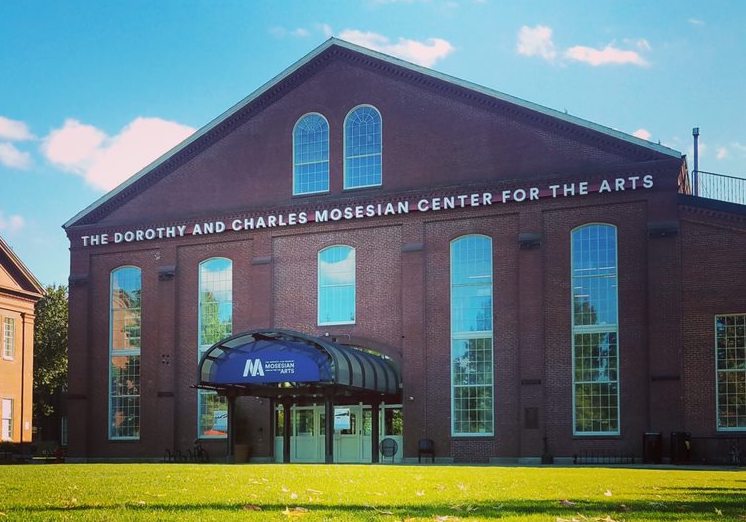December 14, 2018
Coffee with the Cohort: Meet Please Touch the Art
Alicia Deluga (Mosesso)
Alicia sat down with Mosesian Center for the Arts’ Aneleise Ruggles, Assistant Program Director, Matt Jatkola, Graphic Designer, and Karissa Coady, Patron Engagement Coordinator. Their project, Please Touch the Art, is a tactile art exhibit and companion humanities exhibit accompanied by a curator’s talk and panel discussion.
Alicia: Thanks so much for coming today! I know so many people are looking forward to seeing your project come to fruition. Can you speak to the biggest inspiration behind it?
Aneleise: It has been a couple years in the making that we’ve talked about this concept. Given that our arts center is so geographically close to Perkins, we’d have visitors come in who were students or were affiliated with Perkins, and there would be ways for them to come in and interact with our programming, but not necessarily our exhibitions. This was an interesting way to address those audiences and make them feel included in our programming in a thoughtful way, and have a new perspective on how we present our exhibits at the center. That was really the launching point, and since then it has become more about how we address accessibility in general at the institution, making sure there are ways to navigate our space and participate in proactive ways in our programming. We are finding ways for people of all different backgrounds, experiences, and abilities to experience our programming.
Matt: We are constantly trying to find ways for people to engage. You can’t touch art typically, so to break that was appealing to us. Beyond accessibility, for anyone to touch the art is a fun way to get other people to engage. We try to do that as often as we can; we have a unique space, so we are constantly rethinking exhibitions.

Mosesian Center for the Arts. Courtesy of Mosesian Center for the Arts.

Forever Young Picture Book Exhibition. Courtesy of Mosesian Center for the Arts
Alicia: Actually, can you describe the space a little more for folks?
Aneleise: We have six to eight exhibitions per year on three floors of exhibition space, and hundreds of people are in and out of the building every day. The gallery spaces are not isolated: rather, they are incorporated into public spaces. Many kids and students circulate through the building and feel compelled to interact with the art anyway, so to be able to allow them to feel that tactile experience through education and presentation work is incredible.
Karissa: One of the strengths of Sasaki as a partner on this project is that they have dedicated their firm to purpose of place through cross-disciplinary design. This aligns well with our Center, and this project specifically, because we are very intentional about using place to foster community and cross-disciplinary dialogue.
Alicia: What is one of your favorite things about your work on this project?
Aneleise: For me, I think it’s the challenge we presented to our core group of artists and the greater arts community in our region, and how they’re thinking about their art practice and considering who their audiences are for the work they’re creating. Most artists are thinking in a visual sense, but it’s thinking about all the other sensory experiences you’re creating when you’re generating your work (paint brush and paint, water, machine, tools, pottery wheel). It’s a really cool challenge we’re presenting to our artists.
Matt: I’m excited for the challenge of installing the work and making it work in our space. It’s going to be different from what we usually do; we have to make it extremely accessible, so it’s good for us not only from this exhibition standpoint but for us as an organization.
Karissa: To Matt’s second point, I love how this is causing us to think about the future. How are we going to take on these practices through this project and put it into everything we do? Thinking about access not just for populations with disabilities, but for all different kinds of populations we have not necessarily been targeting in the past.
Alicia: Love it. So what are the various ways folks can get involved in your work?
Aneleise: If they are visual artists, they can put together proposals for this exhibit. We also have a robust range of programming that is free and open to the public. We have classes, workshops, and performances; there’s something for everyone. The Please Touch the Art exhibit is open May 23 through September 6, so if folks are interested in seeing and participating in a blindfolded tour or giving tours, or creating wayfinding language for folks who have low vision and blindness (we’re especially interested in the perspectives of first-time visitors), that would be helpful.

Artwork by Elisabeth Higgins O’Connor. Photo by Gary Sexton Photography
If you’d like to connect with folks from the Please Touch the Art project, send an email to info@sasakifoundation.org.
